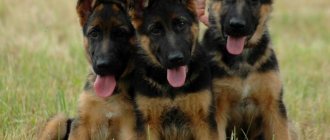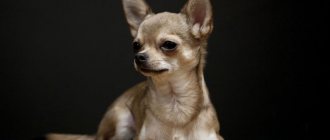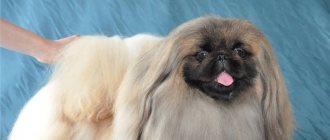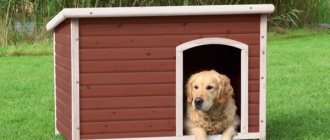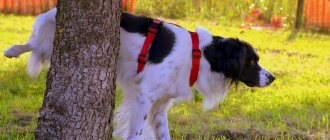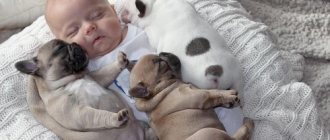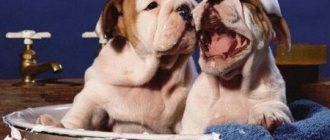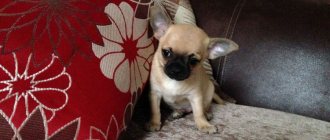Breed characteristics and external data
Labrador is one of the most popular pet breeds. They are distinguished from other animals by their wonderful character. “Labrick” will be a wonderful companion; he willingly adapts to his owner and loves children. Kids of the Labrador Retriever breed are not prone to aggression, they are caring and affectionate. In addition to the initial hunting role, your new friend can serve:
- companion;
- guide;
- lifeguard;
- bloodhound.
A purebred dog can boast of a good appearance. The dog is strongly built, with strong bones. Acceptable height at the withers is 54-57 cm. It has a wide skull, chest, and loin. The dog's front paws are clawed and straight, the toes are arched, with well-developed pads. The coat is short and thick, repels water. The muzzle is massive, wide, with well-developed nostrils. A distinctive feature of the breed is its not very long, thick tail, gradually tapering towards the base, without bending behind the back.
How to choose the right puppy
Choose a Labrador Retriever responsibly, because this is a creature that you will have to take care of for at least 10-15 years. Nuances:
- Do not make this decision yourself; if you do not live alone, be sure to discuss the issue with your family. Distribute caregiving responsibilities among family members, but remember that it will be difficult for a small child to cope with a hyperactive dog.
- Make a decision - you want to have a dog or a bitch. Males for the most part are larger and stronger than females, making them much more difficult to walk with. They strive to show other dogs “who’s boss” and are already interested in the opposite sex at a young age. Girls are more affectionate, calm and become more attached to their owner. Problems with them can arise during the estrus period, which lasts 21 days twice a year.
- Think about where to choose your puppy. You should attend several large dog shows and try to contact an experienced breeder there. In such places, only promising puppies with interesting pedigrees and all the necessary documents are almost always exhibited. There you can also find titled parents for your future retriever.
- The description and cost of puppies can be found on the Internet. Each large breeder has its own website, which describes breed standards and prices. Trusted nurseries can guarantee that puppies will be fully vaccinated. Avoid flea markets where no one can provide the puppy's measurements.
Purpose of acquisition
This is a universal dog with a wide variety of working qualities. The main purposes for purchasing retrievers are for show, breeding, hunting, or just as a pet. The requirements for dogs that will perform are very strict, which will make choosing a puppy difficult. When choosing a hunter, it is important that the dog is not cowardly or timid during puppyhood. For a pet, the main requirements are health, good mental health and an affordable price.
Criterias of choice
- Breeder qualifications - choose proven ones.
- Male or female - according to qualities.
- The price of a puppy varies between 30-60 thousand rubles.
- Working qualities of parents - depending on the purpose of acquisition.
- Temperament and type - according to your preferences.
- The structure of the hairline should be thick and water-repellent.
- The physical condition of the puppy is healthy, plays, vaccinated.
- The tail should be short and thick at the base. Should not curl over the back, as in some breeds.
- Muzzle – with narrow and thick ears; pupils are colorless.
Which coat color do you prefer?
Breed standards allow three types of retriever colors: black, beige (brown) and fawn (dudley). Often future owners think that there are differences other than visual ones. The temperament, character and health of a puppy do not depend in any way on color. The psychological factor is on the side of light-colored dogs - people subconsciously treat them more calmly. Fawn Labrador puppies are widely advertised, which is the description of the dog people imagine when they hear about Labradors.
Where to buy a Labrador Retriever
It is best to buy a Labrador Retriever puppy from well-known nurseries and kennel clubs. It is desirable that institutions be part of the Russian Cynological Federation system and specialize specifically in this breed.
You can also turn to special canine sites and forums, take advantage of advertisements from owners of Labrador Retriever dogs in newspapers such as “Iz Ruk v Ruki”. It is advisable to visit dog shows more often to get acquainted with experienced breeders and take advantage of their advice.
Diet of a small Labrador
A dog, if it is fed correctly, always has the same weight, looks healthy, its coat is shiny and free of dandruff. A good appetite is an indicator that the dog is being fed properly. At a young age, it is better for the pet to be rather thin in appearance than fat, so as not to interfere with the development of tendons and joints. It is better to stick to the diet that the breeder practiced, and only introduce new products over time.
Approximate daily diet for a small Labrador: meat 15 g per 1 kg of dog weight, carbohydrates - 5 g per 1 kg of weight, fats - 2 g per 2 kg of weight. Don't forget to drink - clean water should always be available. Stick to the formula above and avoid:
- fatty pork;
- sausages;
- peppery and spicy foods;
- bones (can lead to constipation);
- spoiled products;
- any sweets.
How many times should you feed your puppy?
Until two months of age, Labrador puppies eat 6 times a day. Do not feed the puppy at night; distribute these 6 feedings throughout the day approximately every 3.5-4 hours, and then, as the number of feedings decreases, increase the interval between them. From 2 to 4 months the puppy is fed 5 times a day, from 4 to 5 months - 4 times, from 5 to 6 months - 3-4 times. From 6 months, gradually transfer your Labrador puppy to the diet of an adult Labrador. From the age of 6 months, feed your Labrador twice – in the morning and in the evening, at certain hours.
What to feed with a natural diet
If you feed your Labrador with regular food, it is important to properly balance the diet. Remember: Labrador puppies are not gourmets, there is no need to try to diversify their food - it is better for the food to be the same, but always complete. Any flavoring additives (spices, ketchups, mayonnaise, etc.) are harmful and dangerous for a dog. Include in your diet:
- Meat is a large part of natural nutrition. Any part of beef is included in the diet (goulash is suitable, take tendons, veins, trachea, cheeks), lamb is recommended. Give the meat raw, fresh or after freezing. You cannot cook it for a long time if it is intended for a dog.
- Vegetables and fruits, herbs (vegetable components are given lightly stewed in a frying pan, boiled in water).
- Porridge. Keep in mind that many people love buckwheat and are allergic to it.
- Dumplings with garlic - recipes step by step with photos. How to cook garlic dumplings in the oven and slow cooker
- How to make your nose smaller with makeup - visually. What you need to reduce your nose with makeup, photos and videos
- Classic crab stick salad: recipes
Premium ready-made food
When feeding your Labrador with ready-made food, there will be no problems with choosing a diet. The question is one thing - the food needs to be selected successfully. Buying the most expensive one will not guarantee that it will suit your dog. Buy food in small packages at first. Study how your Labrador reacts to it, whether there are any allergic reactions: check for redness in the ears, belly, and interdigital spaces. See if your Labrador eats this food with pleasure. Pay attention to dry food from the Holistic line.
Appearance and behavior
You can buy a puppy by separating it from its mother at the age of 45-60 days.
But you can choose it much earlier. You can look for a pet based on appearance and behavior as early as 30 days by observing the babies and their mother. If a bitch greets a stranger with an angry bark or growl, then one can doubt the mental balance of the puppy from her litter. Because such behavior is transmitted at the genetic level. But it is known about Labrador retrievers that their breed is distinguished by its good nature towards any person. At the same time, you can see in what conditions the animals are kept. If the owner has provided his pets with a clean, dry and comfortable room and excellent food, then the puppy’s health will most likely please the future owner. During this time, you can learn a lot from conversations with the dog owner: about the kids’ father; about the nutrition and maintenance of Labrador Retrievers; about the temperament, preferences and behavior of each puppy.
In order to choose the right Labrador Retriever cub for yourself, you need to familiarize yourself with what standards it must meet. To do this, you can invite an expert. It is also important to assess the puppy’s health condition. He should have normal stools, a cold and wet nose, and an elastic stomach.
Anyone in doubt about choosing the sex of a dog should know that females are much more flexible than males. But the latter are distinguished by an active life position. If females look for a partner for mating once a year, then males are constantly concerned about finding a partner.
The coat of a Labrador Retriever is usually completely colored in one of the following colors: white, yellow, chocolate, chestnut, fawn, black. The dog of this breed has a fluffy tail, like an otter. Healthy Labrador Retriever puppies have a thriving appearance and wagging tail. They are active, strong, playful, restless, cheeky, inquisitive and brave.
On the contrary, some people like puppies that are not too active. They're good too. As long as they react normally to being separated from their litter, are not afraid of clapping hands above their heads, and do not shy away from other puppies and people. It is worth remembering that puppies are not very foldable in their structure. It's better to pay attention to their parents.
How to arrange a place of detention
When you have a small puppy, you need to create a “place” for him where the baby can sleep. Place the “place” in a dry, not very warm room - for example, a room or a hallway, not near a central heating radiator, not near a stove, and not on the go. Excessive heat has a bad effect on the animal; it will interfere with your pet’s sleep. It is advisable not to place the puppy in the hallway or kitchen if the size of the apartment allows a different arrangement.
The “place” for the first time can be a small, not deep box (or box), with a mattress pad, which must be washed occasionally. For “space,” avoid drafts. Labrador puppies eagerly go to their place with all the toys and bones. The little Labrador sleeps a lot, so give him that part of the apartment where it is as quiet as possible most of the time.
Features of education and training
As you train your dog, you will develop your own methodology. The main thing is that the classes are friendly and useful. Follow the generally accepted Labrador training tips to help train your puppy:
- Choose a site where there will be no one except you and the dog.
- Classes should be short - children are not able to concentrate for long.
- If you use a toy as a reward, use the item only for activities. Then it will be of great value to the Labrador.
- If you reward with treats, they should be in the form of small pieces that are easy to swallow.
- All “goodies” are excluded from the daily diet.
- End your classes on a happy and positive note.
Where to buy a Labrador in Moscow
It is worth paying attention to nurseries registered according to the rules of the RKF. As a rule, the older the nursery, the more guarantees it can provide. A simple search on the Internet reveals many similar companies in Moscow and St. Petersburg. The Amar Vasant kennel was registered and licensed in 1998, provides free consultations on the selection of puppies, and a detailed description of the dogs is available. Many of the nursery's Labradors have been successfully exhibited at various competitions, including the Russian Championship.
Underwater rocks
Those wishing to breed offspring or take part in exhibitions should take a close look at the puppy, which will later become a pet. Pay attention to its appearance.
There are a number of differences that indicate non-compliance with the standard or poor health:
- narrow and angular muzzle,
- crooked bite,
- colorless pupils,
- elongated or thick ears, low set,
- thin or short neck,
- indirect limbs,
- sparse fur,
- spotted color,
- tail that is too long or curled
- rolled up eyelids.
At the same time, the baby should not be fearful, angry, or inadequate . If aggression is visible in his gaze, this is a bad sign.


